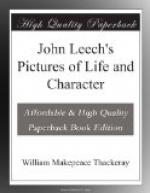After Doctor Syntax, the apparition of Corinthian Tom, Jerry Hawthorn, and the facetious Bob Logic must be recorded—a wondrous history indeed theirs was! When the future student of our manners comes to look over the pictures and the writing of these queer volumes, what will he think of our society, customs, and language in the consulship of Plancus? “Corinthian,” it appears, was the phrase applied to men of fashion and ton in Plancus’s time: they were the brilliant predecessors of the “swell” of the present period—brilliant, but somewhat barbarous, it must be confessed. The Corinthians were in the habit of drinking a great deal too much in Tom Cribb’s parlor: they used to go and see “life” in the gin-shops; of nights, walking home (as well as they could), they used to knock down “Charleys,” poor harmless old watchmen with lanterns, guardians of the streets of Rome, Planco Consule. They perpetrated a vast deal of boxing; they put on the “mufflers” in Jackson’s rooms; they “sported their prads” in the Ring in the Park; they attended cock-fights, and were enlightened patrons of dogs and destroyers of rats. Besides these sports, the delassemens of gentlemen mixing with the people, our patricians, of course, occasionally enjoyed the society of their own class. What a wonderful picture that used to be of Corinthian Tom dancing with Corinthian Kate at Almack’s! What a prodigious dress Kate wore! With what graceful abandon the pair flung their arms about as they swept through the mazy quadrille, with all the noblemen standing round in their stars and uniforms! You may still, doubtless, see the pictures at the British Museum, or find the volumes in the corner of some old country-house library. You are led to suppose that the English aristocracy of 1820 did dance and caper in that way, and box and drink at Tom Cribb’s, and knock down watchmen; and the children of to-day, turning to their elders, may say “Grandmamma, did you wear such a dress as that, when you danced at Almack’s? There was very little of it, grandmamma. Did grandpapa kill many watchmen when he was a young man, and frequent thieves’ gin-shops, cock-fights, and the ring, before you married him? Did he use to talk the extraordinary slang and jargon which is printed in this book? He is very much changed. He seems a gentlemanly old boy enough now.”
In the above-named consulate, when we had grandfathers alive, there would be in the old gentleman’s library in the country two or three old mottled portfolios, or great swollen scrap-books of blue paper, full of the comic prints of grandpapa’s time, ere Plancus ever had the fasces borne before him. These prints were signed Gilray, Bunbury, Rowlandson, Woodward, and some actually George Cruikshank—for George is a veteran now, and he took the etching needle in hand as a child. He caricatured “Boney,” borrowing not a little from Gilray in his first puerile efforts. He drew Louis XVIII. trying on Boney’s boots. Before the century was actually in its teens we believe that George Cruikshank was amusing the public.




